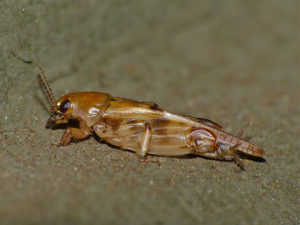Mole Cricket Nymphs
Mole crickets are a relative of grasshoppers and crickets but they mainly live underground. They pass through three life stages, transforming during each phase. Below, we’ll focus mainly on the nymph or newly hatched phase of the mole crickets’ lifespan.
Females lay their eggs underground in damp soil. Once hatched, the mole cricket nymphs continue to live below the surface, feeding on plants that are nearby. There can be as many as 60 eggs in each clutch but the soil must remain moist for the eggs to hatch and the nymphs to survive.
As the mole cricket nymphs grow, they go through several transitions called molts. They begin to look more like adult mole crickets as they continue growing. Nymphs are smaller but as they reach adulthood, they can reach nearly 1.5 inches, depending on the variety. The biggest noticeable difference between a nymph and an adult mole cricket (besides their size) is the lack of wings. Wings are only found on adults but vary in size and functionality based on species.
adult mole cricket (besides their size) is the lack of wings. Wings are only found on adults but vary in size and functionality based on species.
Mole crickets nymphs have front legs specially made for digging and hind legs, that, while they may resemble a true cricket’s, aren’t actually very good for jumping. Instead, these hind legs assist in pushing dirt.
Mole crickets spend most of the year being very active. They slow during the winter, spending it underground as nymphs or adults. Eggs don’t survive the cold weather well but when the warmth of spring returns, they resume activity.
Mole crickets don’t normally present a large threat to lawn health but they can be a nuisance or, if they are in large enough numbers, they can damage the roots of your grass. Knowing how to identify these creatures can help you determine whether they are a threat or the cause of lawn issues you may have. Eliminating them is easiest during the nymph and egg stage as they are more vulnerable.
If you suspect lawn pests causing issues for your landscape, call us today for a consultation!





Sorry, comments are closed for this post.